
Contents
- 1. Importance of sattvik diet
- 2. Types of food according to the method of consumption
- 3. Why is vegetarian diet considered to be devoid of reproductive seed?
- 4. Importance of vegetarian diet
- 5. Why does vegetarianism signify abiding by Dharma?
- 6. Some components of vegetarian diet
- 7. Misconceptions about vegetarian diet, and its superiority
- 8. Prevalent vegetarian dishes and their purity
- 9. Categorisation of essential dietary components into vegetarian and non-vegetarian, according to their nature
- 10. Effects of spiritual practice on diet
1. Importance of sattvik diet
Some of the examples of sattvik food are milk, ghee, rice, various kinds of fruits, vegetables etc. The ghee made from cow milk added to the food served, purifies it and imparts greasiness to the body.
Importance of sattvik food is:
-
Consumption of sattvik food provides momentum to the functions of the five vital energies. The energy created as a result of consumption of sattvik food is similar to the energy created by a sacrificial fire. Due to the sattvik waves transmitted by the consumption of sattvik food, the function of the five vital energies located near the navel gains momentum and these spread in the entire body. For this reason sattvik food is considered ‘Absolute Brahman’ or ‘Purnabrahma’ and that which possesses the capacity to purify the five vital energies.
-
Consumption of sattvik food facilitates the absorption of Deities’ Principles. Consumption of sattvik food purifies a person’s gross and subtle bodies and enables the body to absorb the waves of Deities’ Principles. It is beneficial to consume sattvik food on special dates as per lunar calendar (tithis) and festivals. Hence some non-vegetarians too refrain from consuming non-vegetarian food on the special tithis of their worshipped Deity or festivals.
Some sources of sattvik food:
-
1. Food cooked by a sattvik housewife: The trigunas (three components) of the person who cooks food, influences the one consuming it. The touch of a sattvik woman’s hands facilitates the spread of sattvik vibrations in the food, thus making it sattvik. Such sattvik food which is devoid of Raja-Tama is tastier. Obstacles created by negative energies in the digestion process are also removed.
-
2. Consecrated food (Naivedya) offered to God: In the food items prepared as a part of consecrated food, pure ghee is used instead of oil. The components such as chili, spices etc. are Raja-Tama-dominant. Hence, use of such items is mostly avoided while preparing consecrated food or they are used very little. When such food is offered to God, it becomes charged with the waves of Deities’ Principles, thus becoming more sattvik. By consuming such food as Holy sacrament (Prasad), we benefit from the waves of Deities’ Principles. So as to benefit everyone, the Holy sacrament is distributed to all.
-
3. Food prepared in Saints’ ashrams: As compared to other places, the proportion of sattvikta and Divine consciousness (Chaitanya) is greater in the ashrams of Saints. Here the seekers and disciples prepare food with an attitude of service. Hence this food becomes sattvik. Food is Absolute Brahman (purnabrahma); if one consumes it with spiritual emotion (bhav), one derives Chaitanya.
-
4. Food given by Saints: When devotees visit Saints’ ashrams or when a Saint arrives in their home, they offer various kinds of food, fruits etc. to the Saints. These food items become sattvik and charged with the waves of Chaitanya. These food items are distributed in the form of Holy sacrament (Prasad).
While narrating the limitations of science in understanding the benefits available from consumption of sattvik food, H.H. Gurudev Dr. Kateswami of Maharashtra says: Science has not given due thought to sattvikta of food ! Explaining this point, Swamiji says, ‘Science says that food is necessary for development of the body; but it cannot go beyond this. Science does not give due thought at all to the effects of subtle aspects of food. If the food is vegetarian and sattvik, the mind and intellect become sattvik. Only sattvik food can enable us to perform Yogasadhana and attain God. Only through spiritual science one can know about the sattvikata of food.
Hence as a part sattvik diet, vegetarian diet is of great importance.
Meaning of the word ‘Shakahar’, that is, vegetarian diet: ‘Shaka’ + Ahar = Shakahar. The meaning of the word ‘Shaka’ is ‘pure’. ‘Shakah’ means plant. Shakambarî is also the name of a Female Deity, that is, Devi. This form denotes that the Devi is present in vegetables. Substances such as milk, fruits, roots, bulbs and tubers are included in vegetarian diet.
2. Types of food according
to the method of consumption
-
‘Bhakshyanna’ or hard food which is to be eaten by grinding between the teeth, such as fruit, groundnut, laddu etc.
-
‘Bhojyanna’ or soft food which is to be eaten by chewing such as chapattî, puri etc.
-
‘Choshyanna’ or food which is to be sucked such as mango, sugarcane etc.
-
‘Lehyanna’ or that which can be eaten by licking like rayata, jam, chutney etc.
3. Why is vegetarian diet
considered to be devoid of reproductive seed?
When compared to the animal species, Tama-dominance in the plant species is less. Vegetarian diet is one which is devoid of the capacity to give birth to new beings through sexual contact. These do not have desires or emotions. However, new beings sprout from them. Hence, such components are known as ‘those devoid of reproductive seed’. From the perspective of Ayurved and Spirituality, vegetarian diet is of utmost importance.
4. Importance of vegetarian diet
From ancient times the Sages and Ascetics of Sanatan Hindu Dharma have mentioned the importance of vegetarian diet.
-
Vegetarian diet is a sattvik diet.
-
The teeth of man can easily chew vegetarian food.
-
Proteins are found in necessary proportion in vegetarian diet.
-
Vegetarian people are healthy, blessed with a long life and active.
Men who acquired prominence in various fields in western countries, such as George Bernard Shaw, Plato, Socrates, Aristotle, Tolstoy etc. were vegetarians. Modern science has established the undisputed supremacy of vegetarian diet.
5. Why does vegetarianism
signify abiding by Dharma?
When creating the Universe, God has laid down rules about specific diets for specific beings. As per Nature’s rule, the cow is purely vegetarian. The dental pattern of man is similar to that of the cow’s. Hence, consuming vegetarian food is abiding by Divine rules. Abiding by Dharma means following appropriate Code of Conduct of diet, enhancing Divine qualities and becoming capable of attaining Bliss. As a result of vegetarian diet the sattvaguna in man is enhanced. Vegetarian diet accomplishes the task of making man Divine, that is, man begins to progress on the spiritual path.
6. Some components of vegetarian diet
A. Plants: Plants are animate. Today, even science agrees that plants have emotions. Despite this plants are included in vegetarian diet. There are two main reasons for this.
-
The emotions of plants are not associated with the Tama-dominant actions denoting desire. Wood contains fire in latent form. Hence, plants are considered Holy.
-
Creation of a being (jiva) through the sprouting from a plant is not akin to that of animals, which are born through Tama-dominant sexual contact.
Waves from the earth, in the form of the Absolute Fire and Absolute Earth are present in plants. Due to this jivas that sprout from plants also possess these earth-waves. Plants do not possess waves associated with Tama-dominant sexual desire and its related function.
B. Milk: From a scientific perspective milk, water, air etc. contain microorganisms. As such, how can these components be called vegetarian ? However, from the perspective of Spirituality, these components are predominant in Sattva-Raja-guna. Upon coming in contact with these components, the Raja-Tama-predominant Jivas become inactive.
Components such as milk, water, air etc. possess higher Principles such as the Absolute Fire and Absolute Air. These Principles absorb within themselves all components along with their Raja-Tama. This is why these components are considered vegetarian. Cow milk is the most sattvik and vegetarian component.
Some components of vegetarian diet, their features and effects:
-
Consumption of ghee derived from buffalo milk increases the cholesterol levels in blood. But it is not the same with ghee made from cow’s milk.
-
Regular consumption of fried foods increases the Raja-Tama.
-
Consumption of rice, wheat, lentils and grains increases Sattva-guna in man.
-
Bulbs and Tubers have the Absolute Earth Element in higher proportion.
-
Ghee made from cow’s milk, as well as fruit and leafy vegetables have higher proportion of Vishnu Principle.
6.1 Importance of ghee made from cow’s milk
One of the most important constituent of vegetarian diet is ghee. Subtle-picture of ghee made from cow’s milk is given below:
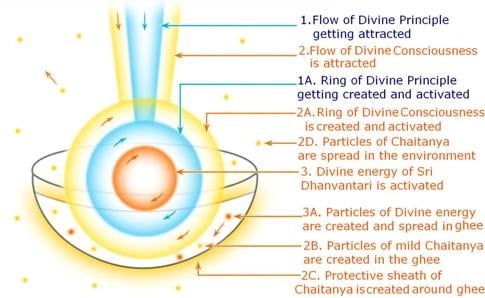
-
As the ghee made from cow’s milk is sattvik, the flow of Divine Principle is attracted to it.
-
A ring of Divine Principle is created and activated in the ghee.
-
-
Flow of Divine consciousness (Chaitanya) is attracted to the ghee.
-
Through this flow, a ring of Chaitanya is created in the ghee and is activated.
-
Particles of mild Chaitanya are also created in the ghee.
-
A protective sheath of Chaitanya is created around the ghee.
-
Particles of Chaitanya are spread in the environment by the ghee made from cow’s milk.
-
-
A ring of Chaitanya-filled Divine Energy (Shakti) of the Deity Sri Dhanvantari is created and is activated.
-
Particles of Divine Energy are also created and spread in the ghee.
-
Ghee contains Divine Principle and Chaitanya. Hence it is protected from negative energies. However use of synthetic substances in the preparation of ghee or preparing it in a distressing environment, may attract negative energies from the environment to it.
Proportion of vibrations in the ghee made from cow’s milk: The table below highlights the spiritual importance of ghee made from cow’s milk. As it is most sattvik, apart from it being used for consumption, it is also used in ritualistic worship.
| Vibrations | Proportion (%) |
|---|---|
| Divine Energy (Shakti) | 1 |
| Divine consciousness (Chaitanya) |
2 |
| Divine Principle | 2 |
7. Misconceptions about
vegetarian diet, and its superiority
Some argue that a purely vegetarian diet weakens a man. He lags behind in the race of life. Non-vegetarians acquire more laurels than vegetarians. But true Hindus understand the importance of a vegetarian diet. By consuming vegetarian diet they increase the Sattva guna in themselves and proceed on the spiritual path. They realise that God is the only One who gives awards. This award is of Supreme Bliss (Brahmananda), non-duality (advait) and Supreme Peace (Param-shanti).
Generally it is observed that vegetarians do not have desire for any other medals or rewards. And talking about weakness, a vegetarian lives longer and there are many examples of this.
8. Prevalent vegetarian
dishes and their purity
Nowadays it has become common practice to eat bakery products like cake and pastry, processed butter, various types of biscuits, drink tea, coffee and different soups. People consider this as pure vegetarian diet. But is it purely vegetarian in the true sense?
-
In bakery items like bread, cake etc., eggs and animal fat is used.
-
Vegetarian restaurants or hotels serve different soups prepared from items like tomatoes, onion, leafy and non-leafy vegetables, corn, green peas etc. To enrich its taste a thick broth of cow or fowl fat is commonly added.
-
Icecream is prepared from milk. There are 25-30 famous icecream flavours. These tastes cannot be created without the use of gelatine. Gelatine is a completely non-vegetarian item.
-
In some medicines supplementing iron, the extract of animal blood is added.
The above examples force us to ponder whether we are actually consuming vegetarian food.
Reason for prohibition of consumption of food like cottage cheese made by the souring of milk: Milk is considered to be a source of sagun Chaitanya. It is a ‘complete food’. Souring of milk amounts to enhancing its adverse Raja-Tama-dominant constituents and destroying those which function with the help of its sattvikta. Consumption of such food items devoid of sattva, prepared by souring of milk is harmful for the body. Due to this, distressing vibrations get concentrated in the body in maximum proportion, thus inviting many diseases.
Some examples of food constituents poisoned with chemicals:
-
Presently, chemical fertilisers are being used to the maximum for crops of wheat, rice, pulses etc.
-
Green grass is given to the cow to eat. In order to keep it green for 10-15 days, chemical substances are used. The milk we get from the cow that eats such poisonous grass is also poisonous.
-
When vegetarians suffering from rickets (a disease of the bones caused by deficiency of Vitamin D) were examined, it was found that the food consumed by them was poisonous.
-
In some medicines supplementing iron, the extract of animal blood is added.
9. Categorisation of essential dietary components into vegetarian and non-vegetarian, according to their nature
A diet includes vegetables, fruits, flowers, milk, grains, lentils, meat etc.. They are categorised into vegetarian or non-vegetarian depending on their nature. Dietary components contain two types of beings organisms.
A. Animate and mobile: Animals / Organisms can move. They are called ‘mobile animate’. Most of such animates are Raja-dominant. Hence they are characterised by instability. These beings / organisms also have desires. These beings also have sexual desire, due to which they are associated with the process of creation. Such beings are slaughtered and their meat is consumed. That is why, mobile animate beings are included in non-vegetarian diet.
B. Immobile animate: The plant species is categorised as immobile animate. These beings / organisms characterised by stability have low ability to function with the help of Raja-Tama-guna. Food items made from such sources are included in vegetarian diet.
| A plant-source diet/Vegetarian diet | An animal-source diet /Non-vegetarian diet | |
|---|---|---|
| 1. Predominant guna | Raja-Sattva | Tama |
| 2. Purity | Pure | Impure |
| 3. Characterised by / Characteristic |
Stability | Instability |
| 4. Effect on the mind | Steady and calm | Fickle and unsteady |
9.1 Difference between
vegetarian and non-vegetarian food
| Vegetarian diet | Non-vegetarian diet | |
|---|---|---|
| 1. Inherent triguna | Raja-Sattva-dominant or Sattva-Raja-dominant |
Tama-Raja-dominant |
| 2. Functional Principle | Absolute Fire-Earth | Absolute Earth- Inferior Fire |
| 3. Functional Divine Energy (Shakti) |
Predominantly Action | Predominantly Desire |
| 4. Vibrations attracted/ concentrated/emitted |
Good | Distressing |
| 5. Effect of the diet | Physical health and purification of the mind |
Deterioration of physical health and mental peace |
| 6A. For the one who consumes |
Reduction in the give and take account |
Increase in the give and take account |
| 6B. For the one that is consumed |
Birth in higher species | Trapped in the same species |
| 7. What kind of thoughts increase? |
About abiding by Code of Conduct (Achar) |
Perverted |
| 8. Protection from negative energies |
Applicable | Not applicable |
Upon consuming food, the law of the cause and effect of our actions (Karmaphal-nyaya) becomes applicable to both, the one who consumes and the one being consumed.
Even Saints have advocated vegetarianism. Due to sattvik food, the body as well as the mind remain healthy. When man consumes the meat of an animal he not only harms it, but does damage to himself too.
Today the number of non vegetarians is increasing. Some people want to give up non-vegetarianism. However, due to habit or the influence of negative energy they are unable to do so. What is the way out? There is only one answer to this, spiritual practice.
10. Effects of spiritual practice on diet
While performing spiritual practice, a seeker begins to establish communion with God. Due to Divine grace, every action of his becomes sattvik and enriched with Chaitanya. When the attitude becomes sattvik, his diet changes too and he becomes vegetarian. By complimenting meal times with prayers, he gains sattvikta, Chaitanya and Deity’s Principle. Of course, mere vegetarianism is not adequate for spiritual progress.
According to the science of Spirituality, a vegetarian diet increases a person’s Sattva–guna and complimenting chanting with spiritual emotion (bhav) increases it more. However, it is not possible for an average person to chant with spiritual emotion. Hence, it becomes necessary to increase one’s Sattva guna by adopting vegetarianism.

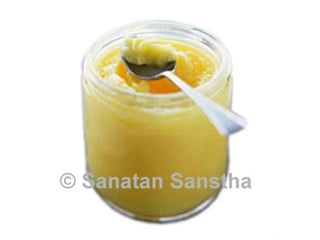
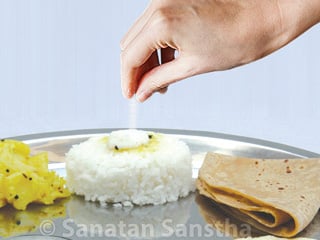 Why use of salt should be restricted ?
Why use of salt should be restricted ? Cow’s milk and the ghee made from Cow's milk
Cow’s milk and the ghee made from Cow's milk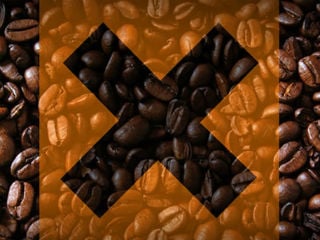 Harmful side effects of Coffee and Tea
Harmful side effects of Coffee and Tea Ill effects of Sugar upon its excessive consumption
Ill effects of Sugar upon its excessive consumption Ill effects of Junk Food, Fast Food and Chocolate
Ill effects of Junk Food, Fast Food and Chocolate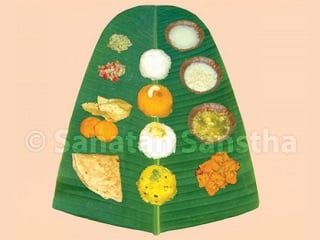 Why the Hindu food preparation (Bharatiya) methods are sattvik?
Why the Hindu food preparation (Bharatiya) methods are sattvik?